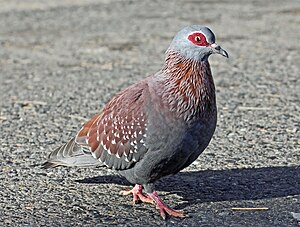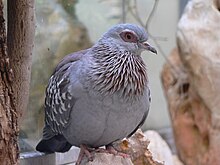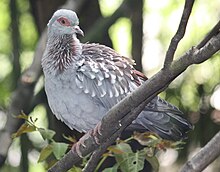Guinea pigeon
| Guinea pigeon | ||||||||||
|---|---|---|---|---|---|---|---|---|---|---|

Guinea pigeon ( Columba guinea ) |
||||||||||
| Systematics | ||||||||||
|
||||||||||
| Scientific name | ||||||||||
| Columba guinea | ||||||||||
| Linnaeus , 1758 |
The speckled pigeon ( Columba guinea ), also Strichelhalstaube called, is an African species from the family of pigeons settled (Columbidae), which mainly open country. According to the IUCN , the guinea pigeon is considered common and not endangered. In many areas it is even expanding its range. It also increasingly uses settlement areas as living space.
The guinea pigeon was bred as an ornamental bird in Great Britain as early as 1885. It is still a valued aviary bird because of its attractive appearance.
features
The guinea dove is about 41 cm long and gray in color. It weighs between 250 and 350 grams. The sexes can hardly be distinguished from the outside.
The guinea dove has reddish brown back and shoulder feathers and reddish brown wing-coverts with triangular white spots. On the neck she has a wide ring of red-brown feathers with gray tips and a greenish sheen. The upper tail-coverts as well as the breast and the belly are gray. The tail feathers are dark and have white borders on the two outer tail feathers. The beak is black with an almost white wax skin. The iris is yellow and has an orange to red outer ring. The area around the eyes is bare and red.
distribution
The guinea pigeon lives in open woodlands and the savannah of Africa . It inhabits a strip from Senegal to Somalia and penetrates further south in the area of the East African Rift Valley . In southern Africa it mainly inhabits Zimbabwe , Botswana , Namibia and South Africa . It is a kind of open living space and also populates cultivated land. In contrast, it is absent in deserts and tropical rainforests .
behavior
The guinea pigeon feeds on plant seeds as well as grain and also peanuts. The food intake takes place mainly on the ground. On the other hand, it picks fruit straight from the trees. In the rocky highlands of Ethiopia, it is occasionally associated with the Amharic pigeon .
In its breeding behavior it is largely similar to the domestic pigeon . The breeding season lasts about 15 days. The female lays two eggs in a nest built on ledges, in trees or in house walls. The incubation period is 15 to 16 days. The nestling period is 20 to 23 days.
supporting documents
literature
- David Gibbs, Eustace Barnes and John Cox: Pigeons and Doves - A Guide to the Pigeons and Doves of the World . Pica Press, Sussex 2001, ISBN 90-74345-26-3 .
- Alois Münst and Josef Wolters: Tauben - The species of wild pigeons , 2nd expanded and revised edition, Verlag Karin Wolters, Bottrop 1999, ISBN 3-9801504-9-6 .
- Gerhard Rösler: The wild pigeons of the earth - free life, keeping and breeding , Verlag M. & H. Schaper, Alfeld-Hannover 1996, ISBN 3-7944-0184-0 .
- David Burnie (Ed.): Vögel , Munich 2008, Dorling Kindersley, ISBN 978-3-8310-1272-5 .
Web links
- Columba guinea in the endangered Red List species the IUCN 2008. Posted by: BirdLife International, 2008. Accessed January 6 of 2009.
- Videos, photos and sound recordings about Columba guinea in the Internet Bird Collection


